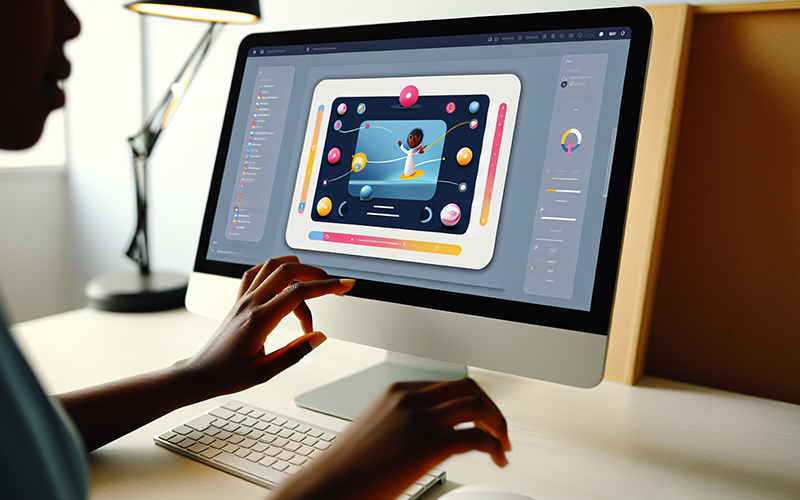Delivering an exceptional user experience through technology isn’t just a goal—it’s a requisite for success in the digital realm. This article cuts through the noise to reveal how technology can be leveraged to refine user experiences, touching on key areas such as immersive interfaces, data-driven personalization, and multi-platform coherence. Expect to uncover actionable strategies that demonstrate technology’s role in elevating the user experience—essential reading for businesses looking to gain the upper hand in user satisfaction.
Key Takeaways
- UX design in the digital age extends beyond aesthetics, emphasizing user-centered design principles and technology integration to exceed user expectations for exceptional digital experiences.
- User research, including persona development, user interviews, and predictive analytics, is foundational to creating usable and accessible designs that reflect user behaviors and preferences.
- Emerging technologies such as artificial intelligence, voice and gesture recognition, and cross-device synchronization are shaping the future of UX by enhancing personalization, accessibility, and seamless experiences.
Decoding user experience in the digital age
The realm of UX design has evolved dramatically in the digital age, with technology serving as a catalyst for this transformation. No longer confined to aesthetics alone, UX design is a symphony of design thinking and user-centered principles, harmoniously orchestrated to meet evolving customer expectations. It’s about aligning the ‘why,’ ‘what,’ and ‘how’ of product use with the user’s perspective, facilitated by technology.
This intricate dance of design and technology delivers digital experiences that not only meet but exceed user needs, thereby paving the way for new market territories, defining brands, and providing an exceptional customer experience.
The role of technology in shaping UX
Technology’s role in shaping UX evolves in tandem with the growth of the digital landscape. Visual design in user interfaces, for instance, is instrumental in creating first impressions, with users forming an opinion about a product in as little as 50 milliseconds. Furthermore, extended reality technologies are now being harnessed by major brands for applications such as training, product trials, and entertainment, pushing the boundaries of immersive experiences.
Meanwhile, micro-interactions, those granular interactions that make the user experience feel intuitive and effortless, are becoming increasingly prominent in modern interface design.
Bridging the gap between users and digital products
A delicate balance is required to bridge users and digital products, which necessitates a profound understanding of users’ mental models, expectations, and interaction scripts. By crafting intuitive designs, we not only increase efficiency and the quality of work, but also reduce the cognitive load on users, making the product easier to use and more appealing.
A user-centric design approach, when paired with intuitive designs, results in a seamless user experience that meets user expectations and creates accessible designs for a wide audience. This is the essence of user centred design.
Crafting interfaces that resonate with users
Crafting interfaces that resonate with users is a crucial component of creating exceptional user experiences. At the heart of this endeavor lies visual design, which employs elements such as:
- lines
- shapes
- negative space
- volume
- value
- color
- texture
To create a cohesive aesthetic. Alongside visual design, usability principles play a crucial role in designing user interfaces that are easy to navigate, understand, and trust, ultimately enhancing user satisfaction and engagement.
The use of design patterns that employ the principle of similarity, like card features for key elements, is one way to attain this. These patterns help to create immediate recognition and lessen the cognitive load on users.
Ultimately, the synergy of visual design and user interface design principles fabricates user interfaces that connect with users and empower them to accomplish their tasks efficiently and confidently.
Visual design: more than just aesthetics
Visual design extends beyond mere aesthetics; it is a strategic tool that:
- Guides user interaction
- Highlights the critical elements within a design
- Fosters a harmonious and balanced arrangement of page elements, ensuring they appear interconnected and do not disrupt the user’s experience
- Reduces user uncertainty by focusing their attention on key aspects of an interface
- Fine-tunes the interplay between innovation and familiarity
Desirability studies further provide insights into user preferences and associations, which can be leveraged to tailor the visual aspects of the user experience.
Usability testing: ensuring intuitive use
Usability testing illuminates the field of UX design, delivering a holistic understanding of the user’s interaction with a product. This process involves:
- Observing users as they interact with a product
- Identifying potential improvements
- Planning
- Defining test parameters
- Setting user tasks
- Recruiting testers
- Using both quantitative and qualitative metrics to assess behavior
It’s a meticulous process that requires careful planning and execution.
Early feedback on wireframes or prototypes enables designers to spot potential issues and implement needed adjustments prior to committing substantial resources.
Accessibility: inclusive design for all users
Accessibility is a cornerstone of importance in the quest for exceptional user experiences. Inclusive design principles and adherence to Web Content Accessibility Guidelines (WCAG) are crucial for making digital products usable by people with a wide range of abilities and disabilities. This includes considerations for color contrast and typography to aid users with visual impairments, and interfaces that are usable with various input methods like mouse, keyboard, or voice commands.
Consequently, the incorporation of voice and gesture controls into traditional graphical user interfaces bolsters accessibility by facilitating hands-free interaction and accommodating users with physical or visual impairments.
Harnessing the power of user research
User research serves as the guiding compass in the voyage of UX design, including the user journey. By employing techniques like ethnographic field studies, surveys, and card sorting, UX professionals can conduct user research to gain valuable insights into how users naturally interact with products. This understanding is critical in ensuring that the final product aligns with user expectations and for creating designs that are usable and accessible to a broad audience.
Don Norman, a trailblazer of user-centered design, once expressed, “Design is fundamentally an act of communication, necessitating a profound understanding of the individual you are communicating with.”
Persona development: crafting your target audience
Persona development is a potent instrument in the designer’s toolkit. Personas provide a reliable and realistic representation of key audience segments for reference, including crucial information such as:
- Demographics
- Behavior patterns
- Motivations
- goals
By effectively developing personas from qualitative and quantitative research, designers can create detailed guides for the development of specific site functionalities and design elements that fulfill the needs of users.
Conducting effective user interviews
User interviews serve as strong resources for gaining a comprehensive understanding of users’ needs. They can be structured, semi-structured, or unstructured, affording researchers flexibility in how they gather deep insights from participants. The key to an effective user interview lies in discussing past user behavior, encouraging elaboration through open-ended questions, and avoiding leading questions that may bias the responses.
Practicing active listening during user interviews with actual users fosters more fruitful and insightful dialogues, resulting in a richer understanding of the user experience.
Predictive analytics: anticipating user behavior
Predictive analytics, which leverages historical data, machine learning algorithms, and statistical techniques to anticipate future user behavior, represents a budding frontier in UX. By personalizing user experiences through content suggestions and recommendations based on analyzed user behavior patterns, predictive analytics reduces friction and simplifies user decision-making.
The key to effective predictive analytics in UX lies in ensuring robust multichannel systems that communicate efficiently and consistently with users across different contexts and devices.
Creating cohesive experiences across multiple devices
In today’s digital era, users anticipate a harmonious experience across all devices that maintains consistent functionality and design. This expectation underscores the importance of responsive design and cross-device synchronization. Responsive design allows interfaces to transition smoothly between desktop and mobile platforms, preserving usability and design aesthetics.
Likewise, cross-device synchronization allows users to start an activity on one device and continue on another without loss of data or context, essential for a fluid user experience.
Responsive design: adapting to screen sizes
The rise of mobile devices has necessitated the development of responsive design to ensure a seamless and optimized experience, irrespective of the device used. With mobile traffic accounting for over half of global traffic, the importance of mobile-optimized websites has never been more evident.
Adopting a mobile-first approach to responsive web design entails first designing for smaller screens and then progressing to larger ones, prioritizing usability and functionality for mobile users.
Synchronizing user data across platforms
In a multi-device world, data synchronization is pivotal. A centralized database with real-time communication is essential for instant updates and synchronization across devices. To achieve this, designers can leverage cloud solutions like real-time databases, which provide scalable and efficient data synchronization across multiple platforms.
The challenge is to maintain consistency during data synchronization, which is where data versioning and conflict resolution mechanisms come into play.
Advancing UX with emerging technologies
Never before have emerging technologies so significantly reshaped the UX landscape. From Web 3.0 and the Metaverse pushing towards interconnected, AI-interpreted platforms to the implementation of Extended Reality (XR) technologies taking center stage in UX design, the possibilities are endless. Similarly, Internet of Things (IoT) advancements necessitate the integration of UX design with trends in hardware miniaturization and advanced analytics.
These innovations, along with technologies like Blockchain, are poised to influence UX design by enhancing aspects such as security, privacy, and secure transactions.
Artificial intelligence: a new frontier in UX
Artificial intelligence (AI) is transforming the UX industry in several ways:
- Altering the nature of design roles
- Introducing novel tools that aid designers with mundane tasks
- Creating adaptive interfaces
- Personalizing user experiences
- Chatbots offering better customer service
- Recommendation algorithms delivering personalized content
Moreover, generative AI significantly simplifies the UX design process by automating recurrent tasks.
Voice and gesture control: beyond the touchscreen
Voice and gesture recognition technology are opening new frontiers in UX design. Some key advancements in this field include:
- Voice interfaces are on the verge of becoming widely adopted and will be integrated into appliances, vehicles, and everyday household items, extending beyond smartphones.
- The future promises improved accuracy and reduced latency in voice recognition technology.
- Language support for voice interfaces is expanding, allowing for more inclusive user experiences.
- Innovative applications of voice and gesture recognition technology are being developed to further enhance user experiences.
These advancements in voice and gesture recognition technology are paving the way for even better user experiences in the future.
As we venture into this promising future, it is crucial to design gestures that are clear, consistent, easy to learn, and minimally affected by external noise or interference.
Fostering a collaborative environment for UX success
Collaboration serves as the vital force within UX design. Remote and hybrid work models require UX designers to adapt their workflows and networking to online environments, fostering a new kind of collaborative workspace. The rise of no-code tools has shifted the collaborative dynamic within UX teams, enabling designers to rapidly prototype and iterate without deep coding knowledge.
By leveraging tools such as Slack, Google Drive, Basecamp, and Jira, clear and open communication among all members of UX teams is maintained, allowing collaborative efforts to thrive.
Tools and platforms for team collaboration
In the sphere of team collaboration, diverse tools and platforms facilitate effective communication and collaboration among UX teams. Some notable tools and platforms for collaboration include:
- Discord: used for less formal communication within co-working channels, offering features such as screen sharing, brainstorming, and group critiques which are enhanced by bots.
- Zoom: a real-time communication platform for video conferencing and screen sharing.
- Google Slides: a collaborative tool for creating and editing presentations.
- Google Docs: a collaborative tool for creating and editing documents.
- Slack: a messaging platform for team communication and collaboration.
- Tandem: a collaborative tool for pair programming and screen sharing.
- Padlet: a virtual bulletin board for collaborative brainstorming and sharing ideas.
These tools and platforms can greatly enhance communication and collaboration within UX teams.
On the design front, Figma and Adobe XD are front-runners in the design collaboration platform space, offering robust functionality for UX/UI designers. Platforms like Whimsical specialize in user flows, task flows, and journey maps, streamlining the communication of ideas. The choice of tools depends on the nature of the project and the team’s requirements, but the common goal is to foster a collaborative environment that promotes innovation and delivers exceptional user experiences.
The role of feedback loops in design iteration
Feedback loops assume a crucial role in the process of design iteration. They form a continuous cycle of gathering, analyzing, and implementing user and stakeholder feedback, crucial for making incremental improvements to the design. Through regular testing with real users and iterating based on feedback, designers can refine the user experience to meet both user needs and business objectives.
Moreover, stakeholders should be periodically invited to:
- Review and provide input during design review meetings with various team members
- Keep the project on track
- Ensure UX aligns with business targets and user needs.
Aligning business goals with user satisfaction
For UX design to achieve genuine success, it must cater to the needs of both the user and the business. This requires integrating user needs in a way that also advances business objectives, as a satisfied user translates to a successful business outcome. For UX designers, this means understanding:
- The company’s business model
- The target market
- The competitive landscape
- The vision, objectives, and key performance indicators of the company.
Holding workshops that include stakeholders, designers, and developers is a strategic approach to ensuring that UX design takes into account and aligns with business objectives.
Balancing user desires with company objectives
Achieving a balance between user desires and company objectives is a delicate endeavor that necessitates collaboration and the involvement of stakeholders. Setting success metrics in collaboration between in-house and external UX teams is crucial to measure the impact of UX efforts and ensure they meet product goals. By tracking changes in the user interface affecting conversion rates, designers can demonstrate their work’s contribution to increasing sales and aligning with business goals.
A UX playbook can provide guidance on how to structure the product development process, from idea generation to implementation, helping to align UX activities with business aims.
Measuring the impact of UX on customer loyalty
Customer experience profoundly impacts customer loyalty. A positive user experience enhances satisfaction, loyalty, and advocacy, resulting in improved business outcomes and increased profitability. For every dollar spent on improving UX, companies can expect a return of up to $100, demonstrating the substantive financial benefits of contributing to customer loyalty.
This impact can be measured by tracking a variety of metrics, including churn rates, repeat visits, engagement levels, and conversion rate changes.
Throughout this exploration of the art of delivering an exceptional user experience through technology, we’ve delved into the intricacies of UX design, the role of technology, the importance of user research, and the impact of emerging technologies. We’ve discussed the significance of collaboration amongst UX teams and the role of feedback loops in design iteration. Above all, we’ve emphasized the critical balance between user satisfaction and business objectives, reinforcing that a successful user experience is one that not only delights the user but also drives business success. As we navigate the continuously evolving digital landscape, these insights will guide us in crafting delightful experiences that resonate with users and drive customer loyalty.
Frequently Asked Questions
How do you deliver a good user experience?
To deliver a good user experience, invite feedback from users, give them a sense of control, cover up mistakes through design, and create pathways and exits out of intended and unintended locations. This will help ensure a positive user experience overall.
How to provide exceptional customer service when using technology?
To provide exceptional customer service when using technology, integrate live chat, cobrowsing, mobile experience, chatbot, analytics tools, social media listening tools, and rethink website navigation to improve customer satisfaction. These strategies can enhance the overall customer experience and address their needs effectively.
Why is user experience important in the digital age?
User experience is important in the digital age because it significantly impacts customer satisfaction, cost reduction, and time to market, ultimately defining brands and opening new market opportunities.
How do voice and gesture control technologies impact user experiences?
Voice and gesture recognition technology enhances user experiences by providing hands-free interaction and catering to users with physical or visual impairments, thereby opening new frontiers in UX design.
What is the role of artificial intelligence in UX design?
Artificial intelligence is transforming the UX industry by changing design jobs, introducing new tools, and enabling the creation of adaptive interfaces and personalized user experiences. This technology plays a crucial role in shaping the future of design.





0 Comments